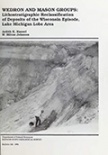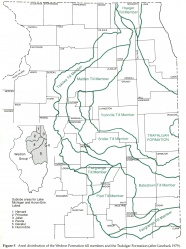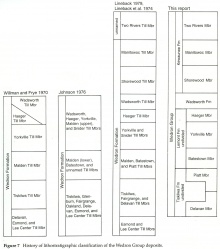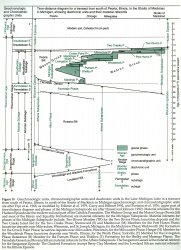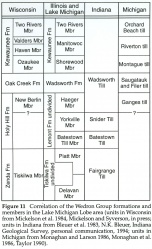Historical:Shorewood Member
Lithostratigraphy: Wedron Group >>Kewaunee Formation >>Shorewood Member
Chronostratigraphy: Cenozoic Erathem >>Quaternary System >>Pleistocene Series
Authors
Ardith K. Hansel and W. Hilton Johnson
Name
Original description
Shorewood Till Member (Lineback et al. 1974).
Derivation
Shorewood, a town along the Lake Michigan shoreline in Milwaukee County, Wisconsin.
History/background
As a result of seismic profiling and coring of the bottom sediments in Lake Michigan by the ISGS and the University of Wisconsin in the early 1970s, several till members were differentiated south of Frankfort, Michigan, by Lineback et al. (1974) (fig. 7). The Shorewood Till Member of the Wedron Formation was described as a red gray to pink gray clayey till, distinguishable from the underlying Wadsworth Till Member and the overlying Manitowoc and Two Rivers Till Members on the basis of clay-mineral and carbonate compositions. On seismic profiles, the Shorewood Till Member was shown to form a prominent terminal moraine on the lake floor (Lineback et al. 1974), where it reaches thicknesses up to 49 meters (161 ft). The Shorewood Till Member was mapped in a belt, 90 kilometers (56 mi) wide, between Milwaukee, Wisconsin, and Muskegan, Michigan. The distribution of the Shorewood Till Member mapped by Lineback et al. (1974, fig. 5) shows a southward protrusion 50 kilometers (31 mi) long on the west side of the lake basin offshore from Waukegan, Illinois. Subsequent coring and seismic studies by the USGS (Colman and Foster 1990) confirmed the presence of the Shorewood Till Member as mapped by Lineback et al. (1974), except in the area of the southern protrusion where core 9V reached a gray, clay-rich diamicton that is clearly equivalent to Wadsworth rather than Shorewood till. The seismic-reflection data also indicated the Shorewood ice margin was north of where it was mapped by Lineback et al.
The Shorewood Till Member is herein renamed the Shorewood Member and reclassified as a member of the Kewaunee Formation.
Type section
Core 911, taken from a bedrock high between the southern and northern basins in Lake Michigan, in 90 meters (295 ft) of water about 48 km (29 mi) east of Shorewood.
Reference section
Cedarburg Lake Bluff Section, Wisconsin; good for lithology of the Shorewood-equivalent Ozaukee Member and lower contact with the Wadsworth-equivalent Oak Creek Formation.
Stratigraphic relationships
The Shorewood Member consists of the lower red gray to pink gray, silty clay diamicton of the Kewaunee Formation beneath Lake Michigan.
Unlike that of the underlying gray Wadsworth Formation, diamicton of the Shorewood Member contains some red hue (pink gray to pink brown), but it is not as brown or red as diamicton of the overlying Manitowoc or Two Rivers Members. Shorewood diamicton contains more expandable clay minerals, chlorite, and vermiculite and less illite than Wadsworth diamicton, but it is more illitic and (like Wadsworth diamicton) lower in total carbonate than diamicton of the overlying red Manitowoc and Two Rivers Members (Wickham et al. 1978).
Extent and thickness
The Shorewood Member forms a wedge-shaped deposit that extends in a belt 90 kilometers (56 mi) wide beneath Lake Michigan between Milwaukee, Wisconsin, and Muskegan, Michigan (Lineback etal. 1974, Foster and Colman 1991). It is thickest to the south, where up to 49 meters (161 ft) was reported in an end moraine that shows up on seismic profiles in the southern basin (Lineback et al. 1974). It thickens in bedrock lows and thins on highs, and it tends to smooth the rugged topography of the bedrock high north of the southern basin of Lake Michigan, where it pinches out beneath the Manitowoc Member.
Lithology
The Shorewood Member consists of calcareous, pink gray to pink brown, silty clay diamicton that contains lenses and beds of gravel, sand, silt, and clay. Shorewood diamicton contains more dolomite than calcite in the clay fraction; in composition and color it is intermediate between diamicton of the gray Wadsworth Formation and that of the red younger members of the Kewaunee Formation.
Contacts
Lower boundary: the contact with a tongue of the Equality Formation, the Wadsworth Formation, older units, or Paleozoic bedrock. Upper boundary: the contact with the Manitowoc Member or the upper tongue of the Equality Formation.
Age and correlation
The Shorewood Member was deposited during the later part of the Michigan Subepisode (early Port Huron Phase) between about 13,000 and 12,500 radiocarbon years ago (Hansel and Johnson 1992; fig. 10). It likely correlates with the Ozaukee Member in eastern Wisconsin and drift of the outer Port Huron moraine (Montague till, Taylor 1990) in Michigan (fig. 11).
|
Environments of deposition
The Shorewood Member is interpreted to be the subglacial and ice-marginal facies of a glacigenic sequence in the Lake Michigan basin; it is predominantly till and subaqueous debris-flow sediment. The sequence was deposited as a result of a major readvance or the ice margin in the lake basin, and the end moraine on the lake floor likely correlates to the outer Port Huron moraine of Leverett and Taylor (1915).
Remarks
Reclassified unit. Renamed the Shorewood Member and unit classified as part of the Kewaunee Formation. Formerly classified as the Shorewood Till Member of the Wedron Formation (Lineback et al. 1974).
References
COLMAN, S. M., and D. S. FOSTER, 1990, Stratigraphy, Descriptions, and Physical Properties of Sediments Cored in Lake Michigan: United States Geological Survey Open File Report 90-478, 92 p.
FOSTER, D. S., and S. M. COLMAN, 1991, Preliminary Interpretation of the High-Resolution Seismic Stratigraphy Beneath Lake Michigan: United States Geological Survey Open File Report 91-21, 42 p.
LEVERETT, F., and F. TAYLOR, 1915, The Pleistocene of Indiana and Michigan and the History of the Great Lakes: United States Geological Survey Monograph 53, 529 p.
LINEBACK, J. A., D. L. GROSS, and R. P. MEYER, 1974, Glacial Tills Under Lake Michigan: Illinois State Geological Survey Environmental Geology Notes 69, 48 p.
HANSEL, A. K., and W. H. JOHNSON, 1992, Fluctuations of the Lake Michigan Lobe during the late Wisconsin Subepisode: Sveriges Geologiska Undersoekning, Series Ca 81, p. 133-144.
TAYLOR, L. D., 1990, Late Wisconsinan till stratigraphy, east shore Lake Michigan, Muskegon to Northport, Michigan: Geological Society of America Abstracts with Programs, v. 22, no. 5, p. 46.
WICKHAM, J .T., D. L. GROSS, J. A. LINEBACK, and R. L. THOMAS, 1978, Late Quaternary Sediments of Lake Michigan: Illinois State Geological Survey Environmental Geology Notes 84, 26 p.
ISGS Codes
| Stratigraphic Code | Geo Unit Designation |
|---|---|
